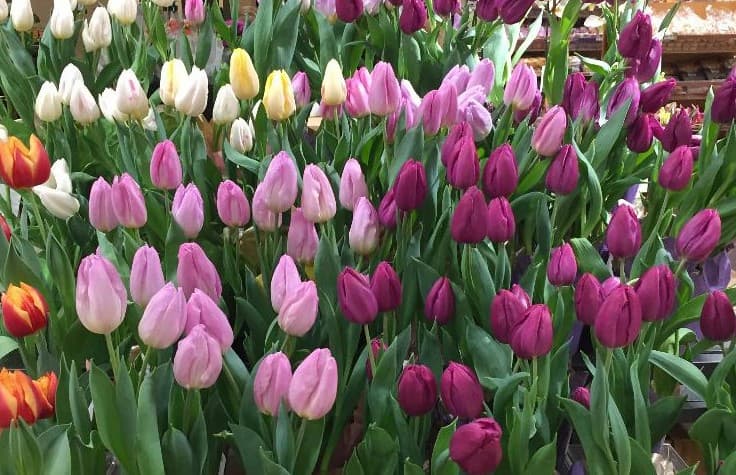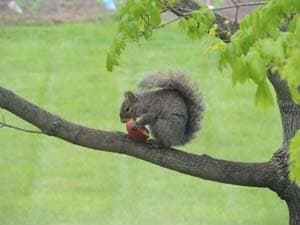How to Grow and Care for Tulip Flowers

About Growing Tulip Flowers in Your Home Flower Garden
There’s no doubt about it. Everybody loves spring-blooming Tulip flowers. That’s why most homeowners grow at least a few of these attractive, easy-to-grow bulbs that herald the arrival of spring. Planting and growing tulips is an art. There are early, middle, and late-blooming varieties. Tulip flowers come in shades of every color of the rainbow, except blue. And, there are countless bicolors, too. So, growers plan eye-appealing designs to fit their landscape and their sense of beauty. The true tulip grower creates a work of art when planting the tulip bed. Some tulip beds are truly a masterpiece, only limited by the imagination of the grower.
Everyone knows that tulips bloom in abundance in the spring. Every gardener, except perhaps the novice gardener, knows that spring-blooming tulips must be planted in the Fall. And, planting tulip bulbs is a fun project.
Size does matter! In the world of tulips, it’s all measured in the circumference of the tulip bulb. This is where the energy is stored for next year’s plant and bloom. The bigger the bulb (measured by its circumference), the bigger the bloom. When you buy tulip bulbs at discounts and in big department(box) stores, chances are you are getting what you pay for. If you want the biggest, best blooms, look for quality, name-brand bulbs.
Garden Tip: After blooming, let the plant continue to grow until it dies off naturally. During the post-bloom period, the plant is sending energy to the bulb to store for use next spring.
Flowers Bloom: Spring
Flower Colors: Shades of every color except blue. There are many bicolored tulips, too.
Plant height: The smallest varieties grow just 6 inches tall. The largest varieties grow up to 3 feet tall.
Plant Hardiness Zones: 4 – 10
Perennial, Tulipia

The Origin of Tulips
Everybody knows that tulips come from Holland, right!? ….wrong. Actually, they are native to Central Asia and Turkey. In the 16th Century, they were brought to Holland from Turkey and quickly became widely popular. They became so wildly popular, that “Tulipmania” occurred in Holland in the 17th century. People traded tulip bulbs for literally a fortune.
Tulips are cultivated in Holland in great numbers in huge fields. Today Dutch bulbs, including tulips and daffodils, are exported around the world.
Store the bulbs in a cool, well-ventilated area. The garage in summer is definitely not the place to keep them. Many inexperienced gardeners pull up bulbs, and keep them in the garage until fall planting, only to find, the bulb dried up a few months later.

Tulip Flower Plant Propagation
Tulip plants are grown from bulbs. Plant new bulbs in the fall after the weather and soil have cooled in your area, but a few weeks before the first expected frost date in your area. They need this time to begin growing a root system.
Add blood meal or bulb fertilizer into the hole at planting time. Then, cover up the bulb with soil. and water them.
Garden Tip: For continuous blooms over several weeks, plant a combination of early, middle, and late blooming varieties.
In general, the larger the Tulip bulb, the larger the plant, flower, and bloom. So, the depth and spacing of the bulbs depend upon the size of the bulb. Here is a general guideline:
For small bulbs: Plant them 3 to 4 inches deep and 2 to 3 inches apart.
For large bulbs: Plant them 5 to 6 inches deep and space them 6 to 8 inches apart.
Garden Note: If the packaging includes spacing guidelines, use them.
The original “Mother” bulb produces new baby bulbs. They are attached near the base of the mother bulb and are easily separated (see picture below). When the plants begin to become over-crowded, dig up the bulbs of established plants. This can be done any time after the plant dies off. Separate the bulbs and store them in a cool, dry place until the Fall. Also, give some excess bulbs to appreciative friends.

How to Grow Tulips
Plant tulip bulbs singly, or in groups. We do not recommend planting a large number of them close together, as they rapidly multiply. In a year or two, that small group will become a major clump of attractive plants, regardless of how many you plant together.
Plant tulips in the fall. When planting tulip bulbs, select a sunny location where the soil is not too wet or soggy over winter and during spring. Importantly, select a spot where you can see them from a window of your house.
Work the soil, adding compost to provide a rich bed for growth. Mix in a generous portion of bulb fertilizer. Plant each bulb singly, or in groups as desired.
The bulbs can be planted using a trowel, or a bulb planter. Plant the bulbs to the proper depth of about 2-3 inches from the top of the bulb. Add a thin (not thick) layer of mulch on top if desired. This will help to protect them from freezing and keep weeds down in the spring.
Your tulip bulbs are now ready for a long winter’s nap. The plants awaken in early spring and bloom in mid to late spring.
Importantly, after the bloom shave died off, allow them to continue to grow until they die back naturally. During this period, they are storing energy in the bulb to produce beautiful tulips next Spring. After the lants die off, cut them to the ground.
Ideal Soil pH: 6.0 – 7.0.
Forcing Tulips to Bloom Indoors
Forcing Tulips to bloom indoors during the winter is a great hobby. When you buy bulbs in the fall, save a bulb or two, to try this fun and easy indoor garden activity. To force bulbs, plant a few in a flowerpot. Then, “chill” the flowerpot by setting it in the cold for a few weeks. After a few weeks, fring the flowerpot indoors, and Voila, the tulips will grow and bloom indoors.
For complete instructions for growing tulips, by forcing tulips and other bulbs to bloom indoors, see Forcing Tulip Bulbs
Insects, Plant Disease, and Pests

Insects and plant diseases are uncommon.
However, rabbits will eat the plants down to the ground. And, squirrels dig up the bulbs for a meal.
Related Articles
Also, people who read this article will like:
Flower Gallery Find pictures of your favorite flowers
Forcing Blooms – If you enjoy growing bulbs, you will also enjoy forcing blooms. Try it on pussy willows, forsythia, lilacs, and many more.
Please support our site. Shop for:
- rmmatthews100@hotmail.com
- 585-721-6528
- Rochester, NY
©1999-2024 GardenersNet.Com, All Rights Reserved

